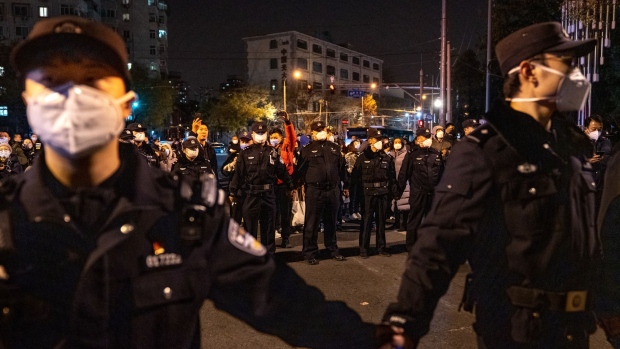Jan 9, 2023
China Says Pivot Away From Covid Zero Predated Mass Protests
, Bloomberg News

(Bloomberg) -- China said it started making major changes to Covid Zero even before nationwide protests widely credited with prompting the shift, as Beijing sought to counter the narrative that President Xi Jinping was forced to abandon a signature policy.
On Nov. 10, “the party central made a major decision, and for the first time put forward a 20-point measure” that relaxed Covid controls, Xinhua News Agency said in a timeline published on Sunday.
“This sent a distinctive signal at home and abroad that China is responding to the time and situation and proactively optimizing its Covid control policies,” the official media outlet said.
The timeline appears to be an effort to minimize the influence that the most widespread demonstrations in China in decades had on Xi and other top decision-makers, instead casting top leaders as carefully planning the change.
The abrupt shift came on Dec. 7, when China dumped key aspects of the zero-tolerance approach, which required mass tests, snap lockdowns and other measures. On Sunday, the Asian nation reopened borders that were largely shut for nearly three years, setting off a homecoming rush.
See: Xi’s Covid Retreat Shows China Masses They Have Real Power
Beijing had consulted with public health experts from Hong Kong before Nov. 11 on how to lift Covid restrictions, according to a Financial Times report based on two people familiar with the matter. That indicates that prior to the protests at least some parts of the government were considering how to exit from the nationwide Covid restrictions which had seriously damaged the economy and pushed the budget deficit to a record.
The controls were also struggling to contain the more infectious omicron variant, with Covid cases in November high or rising in major regions such as Beijing, Chongqing and Guangzhou.
The Chinese leader faced another major test in late November, when protests erupted in dozens of cities. Some demonstrators called for the resignation of Xi, who had repeatedly defended Covid Zero, even as late as mid-October at a party congress that handed him an unprecedented third term in power.
The 69-year-old and his party of some 90 million people who govern a population of 1.4 billion without ever holding elections would be keen to downplay the role of protests in decision-making, likely out of concern it could fuel even more unrest from a public wanting other changes.
Videos have circulated in recent days of people defying police to set off fireworks to celebrate the New Year. In one clip, a young man dances on a damaged police car while a large crowd cheers and takes pictures. Bloomberg wasn’t able to independently verify the videos.
Xi and other top Chinese officials have said little about the protests, the abrupt change to Covid Zero and what comes next. In a New Year’s address, Xi acknowledged divisions in society, and said the Covid strategy had been “optimized” and that the Asian nation faced tough challenges.
He reportedly told European Council President Charles Michel during a visit to Beijing in early December that the protesters were “mainly students and teenagers” frustrated with the pandemic. Protesters seen by Bloomberg News reporters appeared to be from many walks of life.
More: China Cranks Up Propaganda Defending Xi as Covid Surges
The Xinhua timeline avoided the word “protest,” saying only that people in some cities had started to “reflect problems” with Covid controls, which “attracted high-level attention.”
It added that “different people have different views” in such a large country, and that the government worked at “building consensus and making scientific decisions” in response to the pandemic.
Xinhua also tried to defend the Chinese government against criticism it was unprepared for the end of its Covid strategy, leading to virus outbreaks in Beijing and other cities, which suffered from medicine shortages.
It said the government ordered that facilities to treat patients be expanded and resources stockpiled as early as May. The news agency added that officials demanded on Nov. 24 that “medical resources should be prepared and in place before the end of December.”
©2023 Bloomberg L.P.







